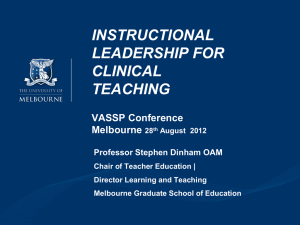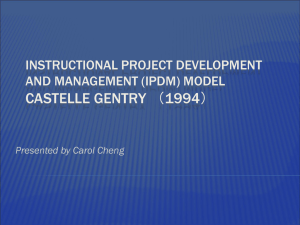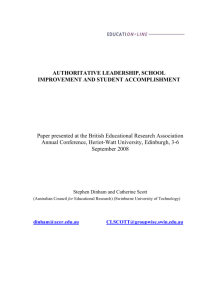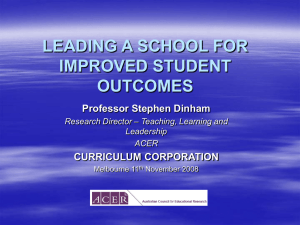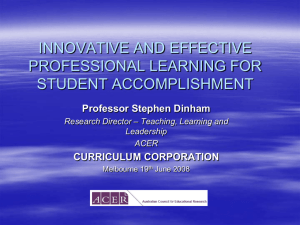Dinham_LEAP_2013 - A Leap For Principals
advertisement
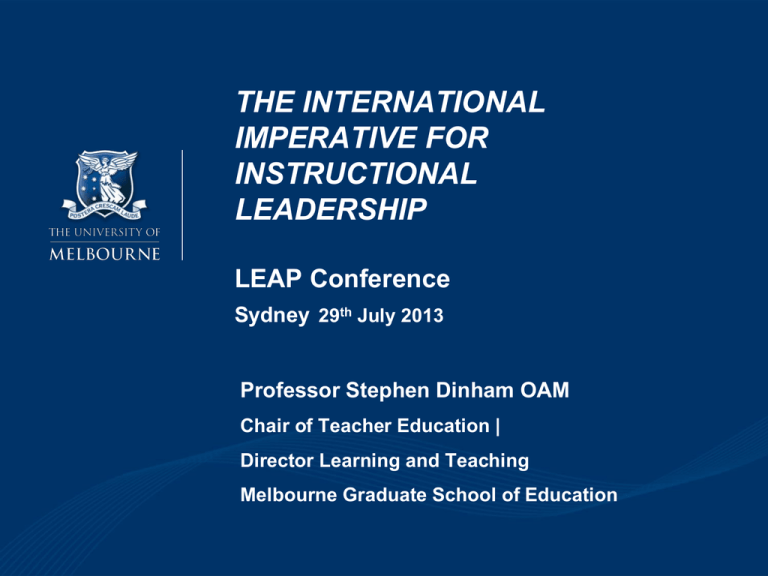
THE INTERNATIONAL IMPERATIVE FOR INSTRUCTIONAL LEADERSHIP LEAP Conference Sydney 29th July 2013 Professor Stephen Dinham OAM Chair of Teacher Education | Director Learning and Teaching Melbourne Graduate School of Education Overview 1. National and international emphases on quality 2. 3. 4. 5. teaching. How and why have approaches to leadership and educational leadership changed? What impact does leadership have on student outcomes? Leadership for teaching and learning: 1. AESOP 2. Authoritative Leadership (introduction to workshop) Connecting clinical teaching and instructional leadership. National and international emphases on quality teaching Background Until the mid-1960s the view was that schools make almost no difference to student achievement, which was largely pre-determined by socio-economic status, family circumstances and innate ability (“Coleman Report”, 1966). However, research has powerfully refuted that view. We now know that teachers, teaching and schools can make a significant difference to student success. Background As a result, there has been a major international emphasis on improving the quality of teachers and teaching since the 1980s. We now know how teacher expertise develops and we know what good teaching looks like. However we also know that teacher quality varies within schools and across the nation. A quality teacher in every classroom is the ultimate aim, but how to achieve this is the big question and challenge. Best Practice ... 'Thus, the major challenge in improving teaching lies not so much in identifying and describing quality teaching, but in developing structures and approaches that ensure widespread use of successful teaching practices: to make best practice, common practice.' (Dinham, Ingvarson & Kleinhenz, 2008) It’s the Teacher … ‘... the most important factor affecting student learning is the teacher. ... The immediate and clear implication of this finding is that seemingly more can be done to improve education by improving the effectiveness of teachers than by any other single factor’. Wright, S.; Horn, S. & Sanders, W. (1997). 'Teacher and Classroom Context Effects on Student Achievement: Implications for Teacher Evaluation', Journal of Personnel Evaluation in Education, 11, pp. 57-67. It’s the Teacher … ‘The quality of teaching is the main driver of successful student learning outcomes. Australia’s teaching profession and its schools constitute an infrastructure that is critical to its survival in an increasingly global economy. Every student deserves teachers who are suited to teaching, well trained and qualified, highly skilled, caring and committed to moving forward the learning of their students.’ (Dinham, Ingvarson & Kleinhenz, 2008) *Dinham (2008) ACER Press http://shop.acer.edu.au/acer-shop/product/A4066BK Four Fundamentals of Student Success (Dinham, 2008)* QUALITY TEACHING FOCUS ON THE STUDENT (Learner, Person) LEADERSHIP PROFESSIONAL LEARNING Raudenbush, S. (2009). ‘The Brown Legacy …’ , Educational Researcher , 38(3), 171. “ … school improvement by itself has potential to make an enormous difference in the lives of children even if broader social change is slow in coming. The children who depend most on good schooling for academic growth are the least likely to receive it. If school improvement begins early in life and if sustained, the most disadvantaged children stand to benefit most. This reasoning suggests that increasing the amount and the quality of schooling to which these children have access would reduce inequality in academic achievement.” The Melbourne Declaration (2008) The Declaration articulates two important goals for education in Australia: ◦ Goal 1: Australian schooling promotes equity and excellence ◦ Goal 2: All young Australians become: ■ successful learners ■ confident and creative individuals ■ active and informed citizens. The Melbourne Declaration is a very good frame for the sorts of evidence we need in schools today. Quality Teachers and Quality Teaching • Defining quality teaching, quality teachers: UNESCO Strategy • • • on Teachers (2012-2015) (2012). http://unesdoc.unesco.org/images/0021/002177/217775e.pdf Schleicher, A. (Ed) (2012). Preparing Teachers and developing School Leaders for the 21st Century. Paris: OECD. http://www.oecd.org/site/eduistp2012/49850576.pdf Dinham, S. ‘The Quality Teaching Movement in Australia Encounters Difficult Terrain: A Personal Perspective’, Australian Journal of Education, 57(2), pp. 91-106. OECD. (nd). Programme for International Student Assessment (PISA) – Strong Performers and Successful Reformers in Education. Paris: OECD. http://www.oecd.org/edu/preschoolandschool/programmeforint ernationalstudentassessmentpisa/strongperformersandsucces sfulreformersineducation.htm Measuring Student Achievement • OECD – PISA http://www.oecd.org/pisa/ • OECD – ‘Shanghai and Hong Kong’ • • • • http://www.oecd.org/pisa/pisaproducts/46581016.pdf TIMSS and PIRLS http://timss.bc.edu/ GEM http://www.gemconsortium.org/ Sahlberg, P. (2012). ‘How Finland Remains Immune to the Global Educational Reform Movement’, Dean’s Lecture Series, University of Melbourne, MGSE, 25th September. http://education.unimelb.edu.au/news_and_activities/events/deans_l ecture_series/pasi_sahlberg Dinham, S. & Scott, C. (2012). ‘Our Asian Schooling Infatuation: the problem of PISA envy’, The Conversation, September. https://theconversation.edu.au/our-asian-schooling-infatuation-theproblem-of-pisa-envy-9435 How and why have approaches to leadership and educational leadership changed? Changing Paradigms of Leadership in Education • ‘Great Man’ theory – personal qualities of ‘great’ leaders • With growth of formal organisations – administration and • • • • • governance Weber – the rational bureaucracy Models, theories, typologies of leadership, contingency Educational Administration – 1950’s onwards; Prof Bill Walker (UNE) ‘Science ‘of Management; corporate influences; MBAs, business degrees 1980’s onwards Parallel wave from 1970’s – effective schools; instructional leadership Changing Paradigms of Leadership in Education • Mid-1980s onwards – Quality Teaching • 1980-1990s – Self-managing schools; ‘transformational • • leadership’, distributed leadership, leading learning communities More recently – return of instructional leadership with a greater emphasis on student learning and the impacts of leadership and [clinical] teaching on student achievement. Context in Australia: • • • • NAPLAN ACARA Australian Professional Teaching Standards International testing Leadership is Important • The more leaders focus their influence, their learning, and their relationships with teachers on the core business of teaching and learning, the greater their influence on student outcomes. (Robinson, Lloyd & Rowe, 2008). • I … advance the following three arguments. First, leadership matters …Second, leadership is inclusive …Third, leadership practices can be taught and learned. (Reeves, 2008) Leadership is Important Ask anyone who has had one or more years working in a school whether leadership has made a difference in their work and the answer will be an unhesitating ‘Yes’. No matter who the respondent is … they all seem to know good (and bad) leadership when they experience it. (Wahlstrom & Louis, 2008). Leadership matters and is changing … School leadership needs to be smart; it needs to be evidence-based and shared. (Mulford, 2008) Leadership is Important Today, the prime focus for any educational leader must be on the academic, personal and social advancement of his or her students. Everything done in a school should be geared to impact in some way on facilitating student achievement, the true core business of teachers and schools. ... The challenge for educational leaders is thus to make things happen in their school and to penetrate the often closed classroom door. While principals are important leaders, they are not the only leaders in schools. Other leaders, formal and informal, through distributed leadership, also play important roles in facilitating student learning. (Dinham, 2009). What impact does leadership have on student outcomes? Relative impact of leadership dimensions (Robinson, Lloyd & Rowe, 2008) 0.42 1. Establishing Goals andexpectations Expectations 1. Establishing goals and 2. Resourcing 2. Resourcingstrategically Strategically 0.31 3. Planning, coordinating and evaluating 3. Planning, Coordinating and teaching and the curriculum Evaluating Teaching and the Curriculum 0.42 4. Promoting and participating in teacher 4. Promoting and Participating in learning and development 0.84 Teacher Learning and Development 5. Ensuring an Orderly and Supportive Environment 5. Ensuring an orderly environment 0.27 0 0.1 0.2 0.3 0.4 0.5 0.6 0.7 Effect Size 0.8 0.9 1 Findings from Action Learning Projects: Bastow Institute Leading Instructional Practice (2013) What Works in transforming teaching and learning? • Listening to students (student to teacher feedback) • • • • • • • Observing learning (not just teaching) Teachers learning together, working in teams Gathering and using evidence Setting, reviewing and revising goals Considering and building for sustainability Striving for teacher understanding, consistency Focusing on teacher explanation Findings from Action Learning Projects: Bastow Institute Leading Instructional Practice (2013) … What Works • Emphasising literacy everywhere • Engendering self-verbalisation • Setting the example, sharing the message • Assessment is broader than marks and grades • Feedback is more than communicating assessment • Prioritising • Finding reasons, not making excuses • Questioning • Sharing success, communicating Findings from Action Learning Projects: Bastow Institute Leading Instructional Practice (2013) The Outcomes • Powerful, enacted teacher learning • • • • • Changing practice, taking charge of learning Teacher inquiry Deep reflection, questioning, open discussion Consistent implementation Growth in student learning, not just measurement The Need for Instructional Leadership • Marzano, Waters and McNulty found (2005): • A highly effective school leader can have a dramatic influence on the overall academic achievement of students. ... a meta-analysis of 35 years of research indicates that school leadership has a substantial effect on student achievement and provides guidance for experienced and aspiring principals alike. Yet Hallinger (2005) observed that despite interest in instructional leadership - leadership of and for teaching and learning - arising from research into effective schools going back as far as the late 1970s (2005): During the mid-1990s, however, attention shifted somewhat away from effective schools and instructional leadership. Interest in these topics was displaced by concepts such as school restructuring and transformational leadership. The Need for Instructional Leadership • However findings from international research have caused a re-examination of the worth of instructional leadership. Robinson, Lloyd and Rowe concluded from their work on the impact of various leadership approaches (2008): The comparison between instructional and transformational leadership showed that the impact [on student outcomes] of the former is three to four times that of the latter. … Educational leadership involves not only building collegial teams, a loyal and cohesive staff, and sharing an inspirational vision. It also involves focusing such relationships on some very specific pedagogical work, and the leadership practices involved are better captured by measures of instructional leadership than of transformational leadership. The Need for Instructional Leadership • While original conceptions of instructional leadership focussed • • predominantly on the principal, the notion of distributed leadership – the leadership practices and effects of others in leadership positions in schools – has become more prevalent. Attention is increasingly turning to the impact of teaching and leadership on student outcomes along with teacher leadership – has become prominent. Barber et al. (2010) found: High-performing [‘top’ 15%] principals focus more on instructional leadership and developing teachers. They see their biggest challenges as improving teaching and curriculum, and they believe that their ability to coach others and support their development is the most important skill of a good school leader. The Need for Instructional Leadership • However penetrating the often closed classroom door remains a challenge for principals and other leaders. Wahlstrom and Louis have commented (2008): In the current era of accountability, a principal’s responsibility for the quality of teachers’ work is simply a fact of life. How to achieve influence over work settings (classrooms) in which they rarely participate is a key dilemma. The Need for Instructional Leadership • Robinson et al’s. conclusions from their meta-analyses support the existence of a disconnect between approaches to leadership and approaches to improving student outcomes (2008): The loose coupling of school leadership and classroom teaching ... is paralleled in the academy by the separation of most leadership research and researchers from research on teaching and learning, and by the popularity of leadership theories that have little educational content. ... Fortunately, the gulf between the two fields is beginning to be bridged by a resurgence of interest in instructional leadership and calls for more focus on the knowledge and skills that leaders need to support teacher learning about how to raise achievement while reducing disparity. Leadership, Teaching and Learning • www.nctq.org/p/publications/docs/mckinsey_education_report.pdf. • Barber, M.; Whelan, F. and Clark, M. (2010). Capturing the Leadership Premium: How the world’s top school systems are building leadership capacity for the future. McKinsey and Company. http://mckinseyonsociety.com/capturing-the-leadership-premium/ • Day, C.; Sammons, P.; Hopkins, D.; Harris, A.; Leithwood, K.; Qing, G.; • • Brown, E.; Ahtaridou, E. and Kington, A. (2009). The Impact of School Leadership on Pupil Outcomes. Nottingham: University of Nottingham. http://dera.ioe.ac.uk/11329/1/DCSF-RR108.pdf Dinham, S. (2008). How to get your School Moving and Improving: An evidence-based approach. Melbourne: ACER Press. Available at: http://research.acer.edu.au/cgi/viewcontent.cgi?article=1137&context=resear ch_conference Robinson, V., Lloyd, C., and Rowe, K. (2008). The impact of leadership on student outcomes: An analysis of the differential effects of leadership types. Educational Administration Quarterly 44(5), pp. 635-674. Leadership for teaching and learning AESOP Authoritative Leadership Dinham, S. (2007). Leadership for Exceptional Educational Outcomes. • See http://www.postpressed.com.au/index.html?aesop/index.html for ÆSOP series PROPOSITION • Leaders’ beliefs, attitudes, mindsets and predispositions are powerful influences on the change that can be achieved in schools. FINDINGS • Principals and other leaders facilitate quality teaching, student achievement and school renewal and improvement through: 1. External Awareness and Engagement • • Openness to Change and Opportunity Develop Productive External Links 2. A Bias Towards Innovation and Action • • Using Discretion, Bending Rules, Procedures Bias to Experimentation, Risk Taking 3. Personal Qualities and Relationships • • • • Leaders have positive attitudes which are contagious Intellectual Capacity Moral Leadership Assist, Feedback, Listen to Staff 3. Personal Qualities and Relationships • • • • • Treat staff, others professionally Expect high standard of professionalism in return Model professionalism Others don’t want to “let down” Provide professional, pleasant facilities 3. Personal Qualities and Relationships Other Personal Qualities • High level interpersonal skills • Generally liked, respected, trusted • Knows, use names, shows personal interest • Demonstrates empathy, compassion • Available at short notice when needed • Epitomises the “servant leader”, yet unmistakably in control • Work for school , students, staff, education, rather than for themselves. 4. Vision, Expectations, Culture of Success • “Expect a lot, give a lot” (highly responsive, highly demanding – see later) • • • • Clear, agreed, high standards The standard things done well Recognition of student, staff Achievement Creates a culture, expectation of success 5. Teacher Learning, Responsibility and Trust • • • • • Investment in teacher learning Teachers are at the core of improvement in student learning All teachers can be leaders Responsibility recognition, empowerment, staff development Trust an aspect of mutual respect 6. Student Support, Common Purpose, Collaboration • • • • Centrality of Student Welfare Support by leaders essential Leaders Find Common Purpose Pockets of like-minded staff, collaboration 7. Focus on Students, Learning and Teaching • Focus on students as people (personal, academic, social) • • • Teaching and learning prime foci of the school Leaders obtain and organise the resources for success Creates and environment where teaching and learning can occur 7. Focus on Students, Learning and Teaching • • • • • • Leadership Takes Time Leaders Build on What is There Consistency, Yet Flexibility in Policy Evidence based practice Vision is knowing where you are going Stand for Something! Comment • Attributes, qualities, approaches neither idealistic nor • • • • prescriptive. Not ‘quick fixes’ or recipes for success, but a framework for reflection and action. Context, history important. Influence of leadership on outstanding outcomes confirmed. Significant role for professional learning. Comment • Two aspects to leadership: – Highly responsive to people and events – Highly demanding of self and others • Principals and other leaders help create conditions, climate, where success can occur. • Characteristics both product (output) and process (input) variables leading to upwards cycle of success. Conclusion Those looking for and advocating quick fixes for struggling schools need to consider the intense, coordinated effort and teamwork under authoritative forms of leadership that such improvement entails. However, the evidence is clear that it can be done. As one participant commented in the ÆSOP study: ◦ ‘in this school we make plans now, not excuses’. Importance of Relationships • Michael Fullan (2001: 5): … we have found that the single factor common to every successful change initiative is that relationships improve. If relationships improve, things get better. If they remain the same or get worse, ground is lost. Thus leaders must be consummate relationship builders with diverse people and groups - especially with people different than themselves. Connecting clinical teaching and instructional leadership. Introduction • There have been long-standing concerns with teacher pre-service • • education. The model of university coursework plus practicum has been criticised. Despite attempts to rectify this situation, only a minority of beginning teachers in Australia rate themselves as being well prepared or very well prepared when they begin teaching. This presentation examines such concerns before offering an alternative. There are two aspects to this new model. – Firstly, a clinical approach to teacher pre-service education coupled with new roles, practices and structures designed to overcome the so-called theory practice gap and enable implementation of evidence-based interventionist practice. – Secondly, the adoption of a clinical approach to teacher education and teaching practice requires understanding, knowledge, commitment and support from education leaders. Educational leaders require a thorough grounding in instructional leadership for clinical teaching if real change towards evidence-based teaching practice for improved student achievement is to occur in schools. Concerns with Teacher Education • In Australia there has been, on average, one major state or national enquiry into teacher education every year for the past 30 years. Inevitably and unfortunately, ‘Each inquiry reaches much the same conclusions and makes much the same recommendations, yet little changes’ (Dinham, 2006). • Darling-Hammond and Baratz-Snowden (2005) provide a succinct summary of these concerns and an emerging trend: In the recent past, traditional teacher preparation often has been criticised for being overly theoretical, having little connection to practice, offering fragmented and incoherent courses, and lacking in a clear, shared conception of teaching among the faculty. Programs that are largely a collection of unrelated courses and that lack a common conception of teaching and learning have been found to be feeble agents for effecting practice among new teachers. ... In response … • However in response: Beginning in the late 1980s, teacher education reforms began to produce program designs representing more integrated, coherent programs that emphasise a consistent vision of good teaching ... The programs teach teachers to do more than simply implement particular techniques; they help teachers to think pedagogically, reason through dilemmas, investigate problems, and analyse student learning to develop appropriate curriculum for a diverse group of learners. Clinical Approaches • There is growing recognition that teachers need to be able to ‘diagnose’ individual student learning and provide appropriate ‘prescriptions’ for improvement i.e., to be clinical, evidence-based, interventionist practitioners in the manner of health professionals. • Teachers have been told for decades that they need to cater for individual student differences and to ‘personalise’ learning, yet generally, have not been shown or taught how to do this. Clinical Approaches • Darling-Hammond and Baratz-Snowden (2005) have noted that successful clinical teacher education programs exhibit: – Clarity of goals, including the use of standards guiding the performances and practices to be developed. – Modelling of good practices by more expert teachers in which teachers make their thinking visible. – Frequent opportunities for practice with continuous formative feedback and coaching. – Multiple opportunities to relate classroom work to university coursework. – Graduated responsibility for all aspects of classroom teaching. – Structured opportunities to reflect on practice with an eye toward improving it. Example of a Clinical Approach: The Master of Teaching at UoM The Master of Teaching [Early Childhood, Primary, Secondary] introduced in 2008 at Melbourne: • A key principle underpinning the MTeach is the focus upon evidence or data about learners to improve teaching practice and to lead to enhanced student learning and development. • A second principle is that in order to break the cycle of teachers teaching as they were taught and new teachers being drawn into this prevailing culture, there needs to be more alignment, understanding and collaboration between the university and schools/early childhood settings. Key Features of the MTeach • Teacher Candidates spend two days per week in a school or • • early childhood centre from early in their studies and undertake placements in block rounds of up to four weeks in each semester. Placement sites (Base Schools [hubs], Placement Schools and early childhood centres) are arranged in neighbourhood groups (networks in early childhood) which have been carefully chosen and where staff have a sound understanding of the program. MGSE funds one staff member at each Base School/centre (40 in total) called a Teaching Fellow, to be released from 50 per cent of their duties to work across the partnership group/network with Candidates, and Mentor [supervising] Teachers to ensure coherent and consistent delivery of the placement. Key Features of the MTeach • The Teaching Fellow [0.5] is joined by a university-based Clinical Specialist [0.2] who supports Teacher Candidates to draw on the work undertaken at university as they seek to meet the needs of individual learners. Most Clinical Specialists are also involved in the teaching of university-based subjects and are well placed to make links between theory and practice. • In order to further embed the links between theory and practice within the program, Clinical Specialists, with the support of Teaching Fellows, organise and deliver a seminar series that runs throughout each semester at a placement/network site. • These partnerships play a key role in supporting the clinical premise of the Master of Teaching, i.e., that teachers who use a specific form of evidence-based, diagnostic, interventionist teaching have a positive effect on student learning outcomes. The program facilitates the role of the teacher to work in teams and use data to enhance decision-making about teaching and learning strategies for individual students, groups and classes. Key Features of the MTeach • Assessment of student work as evidence of learning lies at the core Master of Teaching subjects, a key principle being that with a data-driven, evidence-based approach to teaching and learning, teachers can manipulate the learning environment and scaffold learning for every student, regardless of the student’s development or intellectual capacity. Clinical Judgement for Teaching: The Melbourne approach Master of Teaching: Teaching to inspire W: masterofteachingmelbourne.edu.au © The University of Melbourne Impact of the MTeach to date • A study by the Australian Education Union (2009) asked 1,545 new primary and secondary teachers from across Australia their satisfaction with their training as preparation for teaching. Overall, 40 to 45% claimed that they were ‘well’ or ‘very well’ prepared (on a five point scale) when they began teaching. • When the first MTeach graduates (primary and secondary) were asked the same question as part of an evaluation conducted by ACER late in 2010, 90% reported being ‘well’ or ‘very well’ prepared when they began teaching. Similar [higher] findings have been recorded for Early Childhood graduates. Impact of the MTeach to date The ACER evaluation found: – All respondents [Primary and secondary graduates, Clinical Specialists, Teaching Fellows, Mentor Teachers, Principals, other stakeholders] agreed that the [MTeach] program had impressive strengths, as evident in the: • Integration of theory and practice. • Emphasis on evidence-based practice. • Increased awareness and engagement with aspects of the • • • • profession by Teacher Candidates. Development of Candidates, who come into the profession with knowledge of ‘best practice’. Emphasis on deep reflection and on reflective practice in the course giving Candidates an opportunity to change as they go along. Recognition that Candidates have an important role to play in increasing standards in the profession. High levels of support for Candidates from Clinical Specialists, Teaching Fellows and school-based staff. The Need for Educational Leaders to Understand and Support Clinical Practice • These findings are encouraging – although the MTeach is a work in progress - but producing well trained clinical practitioners is not enough. • If real change in teachers’ clinical assessment and interventionist capabilities is to occur, school leaders must be informed, supportive and equipped to assist in this process of changing the way teachers think, what they know and how they teach. • A key concern is the professional development of the bulk of the teaching profession who may have decades of service ahead of them. Leaders have a key role here. Conclusion • Quality teaching lies at the heart of attempts to raise student • • outcomes and to close achievement gaps associated with factors such as socio-economic status, family background, geographic isolation, non-English speaking background and Aboriginality. Research findings are increasingly compelling on the relationship between instructional leadership, effective teaching and student outcomes yet much work remains to be done. As teaching becomes more evidence-based, clinical and interventionist in nature, it is imperative that school leaders are equipped to guide, support and lead teachers in this process. This central role is recognised in the recent Australian Professional Standard for Principals. Conclusion • Twenty First Century educational leaders need to be able to ‘talk the talk’ and more importantly, ‘walk the walk’ on approaches that place the individual student and his or her advancement at the centre of the school. • In order to make best teaching practice common practice (Dinham, Ingvarson & Kleinhenz, 2008), preparation for and the enactment of instructional leadership must be congruent with teachers’ initial and ongoing professional learning to ensure evidence-based, clinical professional practice occurs in every classroom and for every student. One Response … Master of Instructional Leadership (UoM) • ‘Book-ends’ the Master of Teaching • http://education.unimelb.edu.au/study_with_us/profession al_development/course_list/instructional_leadership Clinical Teaching • Alter, J. and Coggshall. J.G. 2009. Teaching as a clinical • • practice profession: implications for teacher preparation and state policy. New York: National Comprehensive Centre for Teacher Quality. http://www.tqsource.org/publications/clinicalPractice.pdf Dinham, S. (2013). ‘Connecting Instructional Leadership With Clinical Teaching Practice’, Australian Journal of Education, 57(3), [in press] McLean Davies, L.; Anderson, M.; Deans, J.; Dinham, S.; Griffin, P.; Kameniar, B.; Page, J.; Reid, C.; Rickards, F.; Tayler, C. and Tyler, D. (2013). ‘Masterly Preparation: Clinical practice in a graduate pre-service teacher education program’, Journal of Education for Teaching, 39(1), pp. 93-106. IT’S AUTHORITATIVE LEADERSHIP THAT MAKES THE DIFFERENCE Workshop Parenting, Teaching and Leadership Styles • Teaching and educational leadership, like life generally, are heavily dependent on relationships. Parenting Styles • Work of Diana Baumrind on parenting styles • Two dimensions underlie parenting style: Responsiveness - ‘the extent to which parents intentionally foster individuality, self-regulation and assertion by being attuned, supportive, and acquiescent to children’s special needs and demands’. Demandingness - ‘the claims parents make on children to become integrated into the family whole, by their maturity demands, supervision, disciplinary efforts and willingness to confront the child who disobeys’. (Baumrind, 1991: 62) Four Parenting Styles • Uninvolved – low responsiveness, low demandingness; • Authoritarian - low responsiveness, high demandingness; • Permissive – high responsiveness, low demandingness, • and Authoritative – high responsiveness, high demandingness. Authoritative Parenting “… authoritative parents are high on both responsiveness and demandingness. They are warm and supportive of their children, aware of their current developmental levels and sensitive to their needs. They also, however, have high expectations, and set appropriate limits while providing structure and consistent rules, the reasons for which they explain to their children, rather than simply expecting unthinking obedience. Authoritative Parenting While they maintain adult authority they are also willing to listen to their child and to negotiate about rules and situations. This combination of sensitivity, caring, high expectations and structure has been shown to have the best consequences for children, who commonly display academic achievement, good social skills, moral maturity, autonomy and high self esteem.” (Scott & Dinham, 2005) Enhancing Student Achievement and Self Esteem • “We argued that an authoritative teaching style where high responsiveness is accompanied with high demandingness provides the best model for enhancing both student achievement and self esteem, and that a pre-occupation with building student self esteem through a permissive approach in the hope that this will translate into student achievement and development is counter productive. Enhancing Student Achievement and Self Esteem We noted recent research where schools that were successful in facilitating students’ academic, personal and social development achieved this through an effective balance of focus on student achievement and student welfare, regardless of whether the school might be perceived by others as being either a ‘welfare’ or ‘academic’ school, an unhelpful and damaging false dichotomy” (Scott & Dinham, 2005; Dinham, 2005, 2010). Question • Can the four types of parenting identified by Baumrind be productively applied to educational leadership? Four Types of Leadership • Uninvolved Leadership • Authoritarian Leadership • Permissive Leadership • Authoritative Leadership RESPONSIVENESS DEMANDINGNESS Low High Low High Authoritarian Leadership Authoritative Leadership Uninvolved Leadership Permissive Leadership 1Uninvolved • • • • • • Leadership Low responsiveness and low demandingness May be an efficient administrator Staff left to own devices; little control or direction Feedback (positive and negative) lacking Students perceive as remote Standards and expectations unclear and possibly too low …Uninvolved Leadership • Inconsistency, uncertainty can lead to confusion, conflict (Balkanisation, Groupthink) and poor performance • Insufficient attention to key functions (planning, policies, recruitment, induction, systems, communication, evaluation) • Organisation is reactive, drifting, sinking • Other leaders and groups may attempt to keep afloat, or push in other directions 2. Authoritarian Leadership • High demandingness, low responsiveness • Obedience, compliance, respect, status, for position rather than person Tend not to negotiate Focus on procedures rather than people • • • Feedback to ensure control and authority • Standards and expectations can be high, reinforced by • extrinsic mechanisms Control at expense of flexibility …Authoritarian Leadership • School may be orderly, well run with delegation, reporting, accountability • Can be high degree of dependency on the leader • Untapped potential; staff and students can be infantilised • Some will appreciate strength and direction of the authoritarian leader, others will feel stifled and frustrated 3. Permissive Leadership • High responsiveness, low demandingness • Good people skills, open and responsive to needs of • • • others Spend time being available, seeking input, building consensus Planning and decision making can take some time; may find it difficult to be decisive Staff and students allowed a fair degree of latitude …Permissive Leadership • Lack of direction, accountability, organisational looseness • Trust and leeway may be exploited • May be reluctant to intervene or confront; small problems • • • can grow Standards and expectations can be unclear, contradictory, too low Some staff will flourish, others will drift Schools may be happy, sociable, at expense of progress. 4. Authoritative Leadership • High responsiveness and high demandingness – Best aspects of authoritarian and permissive leadership • • • • Warm, supportive, sensitive to others, inclusive Good listeners, networkers Personal qualities admired, respected Clear, high expectations of themselves and others …Authoritative Leadership • Sets an example: ‘Give a lot, expect a lot’ • Knows when to consult and when to be decisive, • • courageous Places teaching and learning at the centre of the school; pupil welfare underpins academic success Seeks to develop competent, assertive, self-regulated staff and students …Authoritative Leadership • Clear, effective, consistent policies and procedures • Timely, effective feedback, good and bad; people ‘know • • • where they stand’ Practices distributive leadership Strong emphasis on professional learning; models for others Strong, clear vision for school …Authoritative Leadership • Bias towards innovation, action, experimentation, • • • • ‘permission to play’ Empowerment; trust, potential recognised, released; strategic, pragmatic; contagion effects Evaluation, evidence, planning, action Change used to advantage, rather than reactive, defensive Leadership sustainability, succession, facilitated. Authoritative Leaders • Authoritative leaders are ‘relationship’ people, able to ‘read’ and respond to others. They understand people and they understand change, which they help others to appreciate and to come to grips with. They are authentic leaders, in that they model those qualities, attributes and behaviours they expect of others. • Authoritative leaders rely more on moral than positional authority, and influence more than overt control. In their relationships with teachers and students, authoritative leaders balance a high degree of responsiveness with a high degree of demandingness. • What sort of relationships would you hope to see in a school? Implications? Conclusion • Michael Fullan (2001: 5): … we have found that the single factor common to every successful change initiative is that relationships improve. If relationships improve, things get better. If they remain the same or get worse, ground is lost. Thus leaders must be consummate relationship builders with diverse people and groups - especially with people different than themselves. © Copyright The University of Melbourne 2009
